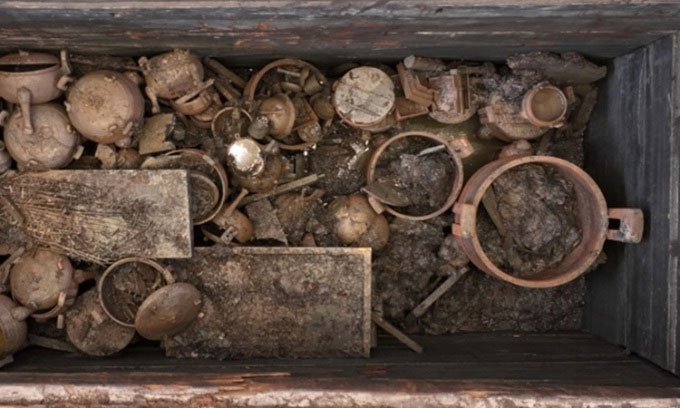Unearthing a 2,200-year-old tomb that may belong to the King of So
Archaeologists speculate that the largest and most advanced 2,200-year-old tomb from the Warring States period may belong to King So Khae Liet, who ruled 262 - 238 BC.
Gong Xicheng, a researcher at Anhui Provincial Institute of Cultural Heritage and Archeology, shared that experts are trying to complete the excavation of the Wuwangdun tomb, which is about 1.5 square meters wide in this province this year. According to him, maybe then the mystery of the tomb owner's identity will be clear, Global News reported.

Part of the artifacts in Wuwangdun tomb. (Photo: Xinhua).
The tomb dates back to the Warring States period and is the largest and most high-ranking tomb from the state of Chu . In its heyday, Chu ruled large areas along the middle and lower branches of the Yangtze River. The State of Chu existed for about 800 years before being invaded in 223 BC by emperor Qin Shi Huang, who later unified China. Over the years, researchers have debated who the tomb was built for.
Among the most potential subjects, the research team leaned on King So Khao Liet , the king who ruled the state of Chu for more than 20 years during the Warring States period. His real name was Hung Hoan, he ruled from 262 to 238 BC. As crown prince, King So Khae Liet was taken to the more powerful Qin state as a hostage at the age of 17. He lived in the capital of Qin for 10 years and married the daughter of the king of Qin before fleeing to Chu to inherit the throne.
In 241 BC, in the last days of the Chu state, the King of Chu Kailie moved the capital east to Shochun, today located in Huainan city, Anhui province. Tho Xuan was the last capital of the Chu state and Wuwangdun tomb is located about 15km from the ruins of the ancient capital. According to Chinese history books such as Sima Qian's Historical Records, King So Khao Liet had no sons. His successor was Hung Han, the son of a mandarin.
Ongoing research has helped protect the Wuwangdun tomb since 2020. To date, the archaeological team has unearthed more than 1,000 artifacts, from bronze pots and household utensils, to lacquerware and wooden furniture, to musical instruments and statues. They also found a large number of inscriptions in the tomb, which could reveal society during the Chu Dynasty and the late Warring States period.
- The skeptical expert went to the secret room hidden in King Tut's tomb
- The hidden room in King Tut's tomb is full of treasures
- Discovered the original Korean king's tomb after 1,000 years
- Egypt made a false tomb for King Tut
- King Richard III will be buried
- Unearthing a 900-year-old ancient tomb suddenly discovered a strange 'treasure'
- The truth curse in the King of Poland's tomb
- Preserve the King of England with 3D technology
- Found the tomb of the Nguyen Dynasty's wife at the construction site
- Digging for the tomb of King Quang Trung after more than 200 years
- Egypt examined Tut's tomb to find Queen Nefertiti
- Question: The location of King Richard III's tomb in England is in the car park
 Discovered an ancient centipede fossil 99 million years old
Discovered an ancient centipede fossil 99 million years old Discovered bat-like dinosaurs in China
Discovered bat-like dinosaurs in China Discovered a 200-year-old bronze cannon of the coast
Discovered a 200-year-old bronze cannon of the coast Discover 305 million-year-old spider fossils
Discover 305 million-year-old spider fossils